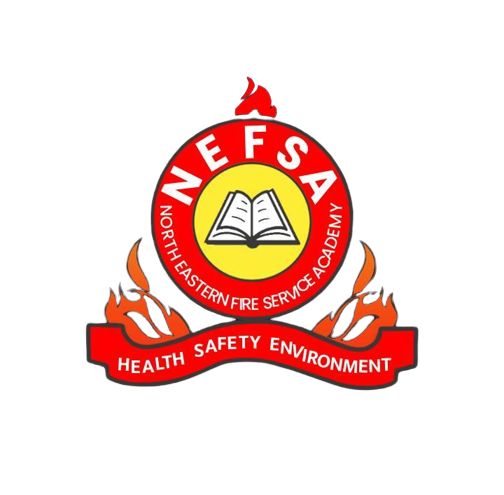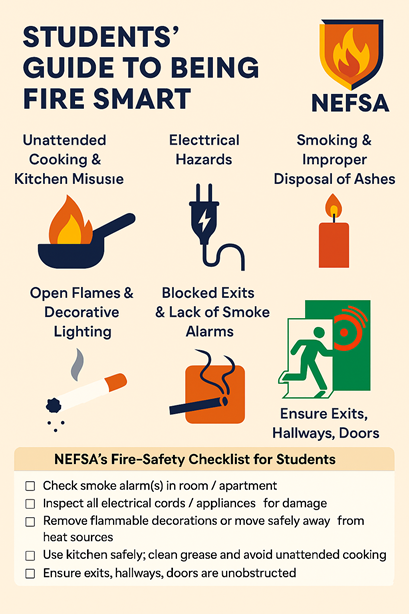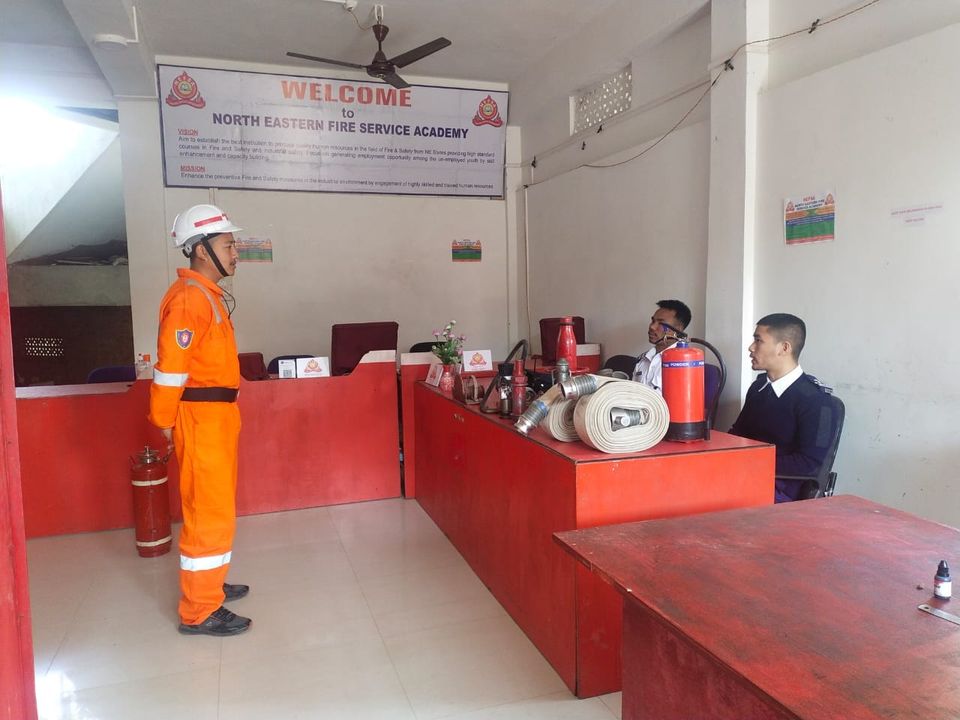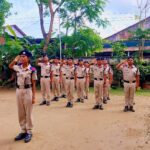Stepping into college or university life usually means more independence: staying up late, cooking your own meals, buying your own gadgets, and decorating your room exactly how you like. But with independence comes responsibility — especially fire safety.
At NEFSA, we believe knowledge is power. Knowing fire hazards and how to avoid them can mean the difference between a small accident and a disaster. In this guide, we cover the top 5 fire hazards students must know, explain why they’re dangerous, and offer real, practical steps to stay safe.
1. Unattended Cooking & Kitchen Misuse
Why it’s dangerous
-
Cooking is cited as one of the leading causes of house and dorm fires. Leaving pots or pans unattended, grease splashes, or using flammable items near hot surfaces can quickly ignite.
-
Most cooking fires start from simple mistakes — forgetting about a stovetop, spilling oil, or letting towels/packaging get too close to burners.
How students can prevent it
-
Always monitor what you’re cooking. If you step away, turn off the heat or remove the pan.
-
Keep flammable items (kitchen towels, packaging, paper) away from the stove or hot surfaces.
-
Use timer reminders. Even a cheap kitchen timer or phone alarm can help.
-
Clean grease from pans, oven surfaces, and stove tops regularly. Grease buildup ignites easily.
-
Only use kitchen appliances (microwaves, hot plates) where allowed by your residence policy.
2. Electrical Hazards: Overloading & Poorly Maintained Wiring
Why it’s dangerous
-
Extension cords, power strips, or adapters that are overloaded or not certified can overheat and spark fires.
-
Damaged wires, frayed cords, or using electronics near water or damp areas are frequent causes.
How to stay safe
-
Use only UL- or CE-certified adapters, surge protectors, and power strips. Don’t daisy-chain multiple extension cords.
-
Avoid plugging too many high-power devices (heaters, irons, ovens) into a single outlet.
-
Inspect cords: if they are cracked, frayed, or over-heated (feel warm), replace them.
-
Keep cords away from walkways where they can be stepped on, bent, or damaged.
-
Unplug small appliances when not in use.
3. Open Flames, Candles, Incense & Decorative Lighting
Why it’s dangerous
-
Candles or incense are common for ambiance or stress relief. But open flames plus fabric, paper, or curtains easily leads to burns or fire.
-
Decorative string lights or other lighting decorations, especially non-certified or overloaded lighting, can overheat/explode or ignite nearby materials.
Tips for safer use
-
If possible, use flameless LED candles instead of real candles.
-
Never leave open flames unattended. Always extinguish them before sleeping or leaving the room.
-
Use sturdy, non-combustible holders and keep flames far from anything flammable (curtains, papers, posters).
-
Check that decorative lights are approved, not damaged, suitable for indoor use, and not overloaded. Turn off decorative lights when not in use.
4. Smoking, Vaping & Improper Disposal of Ashes/Lighters
Why it’s dangerous
-
Smoking (traditional cigarettes or using devices like vapes) is often tied to fatal dorm and off-campus fires — especially when people smoke in bed, discard hot ashes carelessly, or mix smoking with alcohol.
-
Lighters, matches and discarded cigarettes can ignite fabrics, bedding, or mattresses.
What students should keep in mind
-
Smoke only in designated areas and ensure ashes or cigarette butts are fully extinguished and cooled before disposing. Use deep, non-flammable ashtrays.
-
Don’t smoke in bed or when sleepy, drunk, or under the influence.
-
Store lighters or matches away from reach of children or curious roommates.
5. Blocked Exits, Lack of Smoke Alarms & Poor Awareness/Escape Planning
Why it’s dangerous
-
In many campus fire incidents, smoke alarms are missing, disabled, or batteries are removed. When an alarm does sound, people may not know the nearest exit routes or get panic.
-
Sometimes hallways, stairwells, or exit doors are blocked with clutter, furniture, or other items — this slows escape or makes exit impossible.
What to do to be prepared
-
Confirm that your dorm, apartment or shared home has working smoke alarms. Check/test them regularly. Replace batteries. Don’t tamper with alarms.
-
Be familiar with all exit routes in your building — windows, doors, stairs. Know two ways out of every room if possible.
-
Keep corridors, stairways, and exits clear at all times. Don’t block doors or prop open fire doors.
-
Participate in drills if your institution offers them. Practice escape plans. Talk with your roommates or hallmates about what to do in case of a fire.
NEFSA’s Fire-Safety Checklist for Students
Here’s a quick checklist you can use today to reduce your risk:
| ✅ Item | ✔ Completed? |
|---|---|
| Check smoke alarm(s) in room / apartment | |
| Inspect all electrical cords/appliances for damage | |
| Remove flammable decorations or move them safely away from heat sources | |
| Use kitchen safely; clean grease and avoid unattended cooking | |
| Ensure exits, hallways, doors are unobstructed | |
| Store lighters / matches safely |
Conclusion
Living away from home gives students much freedom — but that comes with the need for awareness. Fires can start from everyday things: cooking, lighting, electrical overloads. The good news is that many fire hazards are avoidable with smart habits, regular checks, and being prepared.
At NEFSA, we encourage all students to not just learn these risks — but to take action. Talk with your roommates. Make a plan. Practice safety. Because when you know the hazards, you can prevent the worst. Stay safe, stay prepared.
FAQs
Q1: Are fire extinguishers useful in dorm rooms?
A: Yes — if your dorm allows them and you are trained. Small trash or cooking-fires can sometimes be controlled, but safety always comes first. Know your building’s policy.
Q2: What kind of smoke alarm should I buy (or expect)?
A: Look for alarms with battery backups, UL/CE certification, easy-to-test buttons. If possible, get alarms that also alert automatically.
Q3: How often should I review my escape plan?
A: At least once per semester, or whenever someone moves in or out. Also whenever there are changes like new furniture, renovations or shared room practices.
Contact us today to know more about admissions, batch schedules, and course details.
Visit: www.nefsaindia.com
Location: Dibrugarh, Assam
For More Blogs:- Click here







